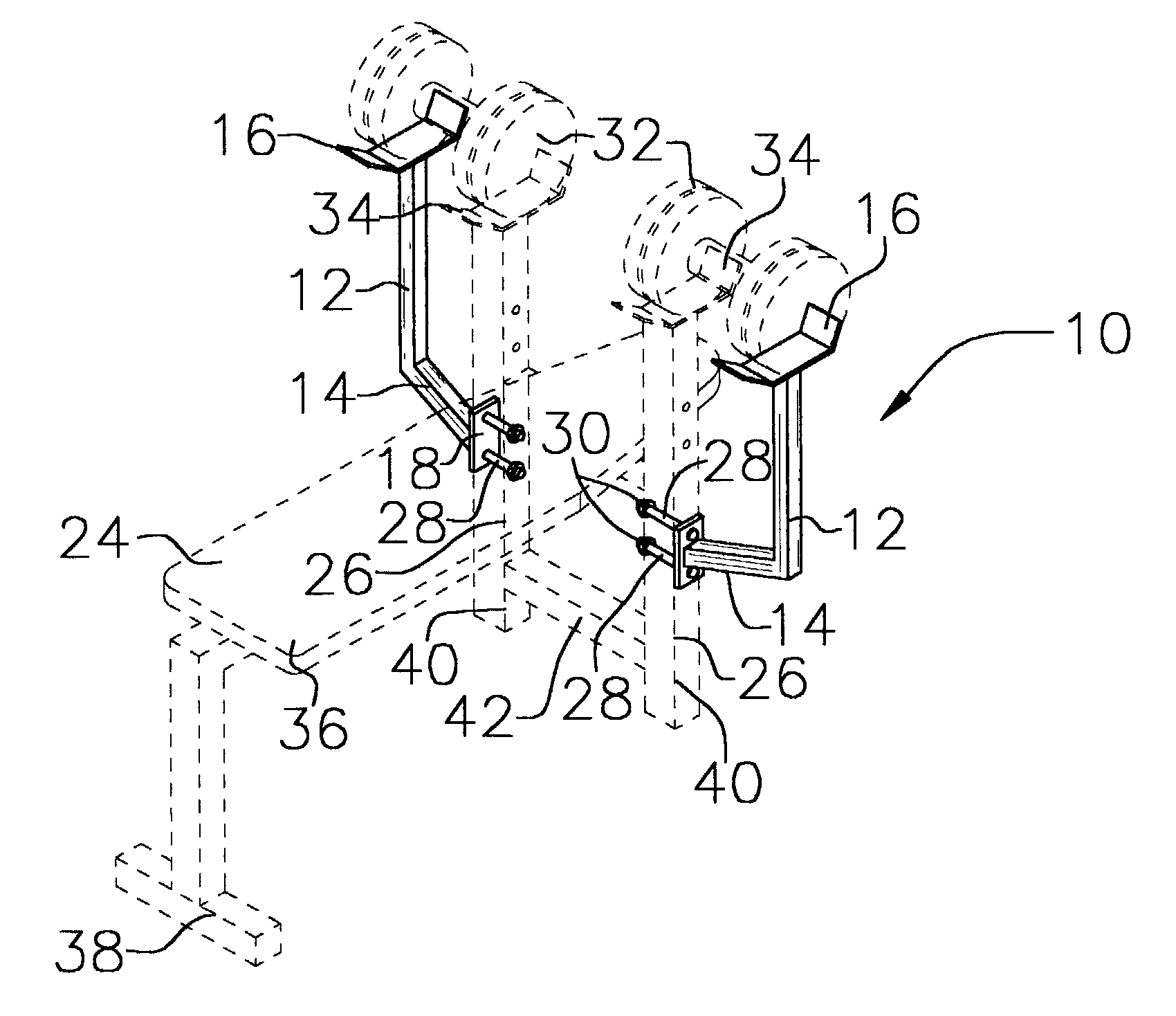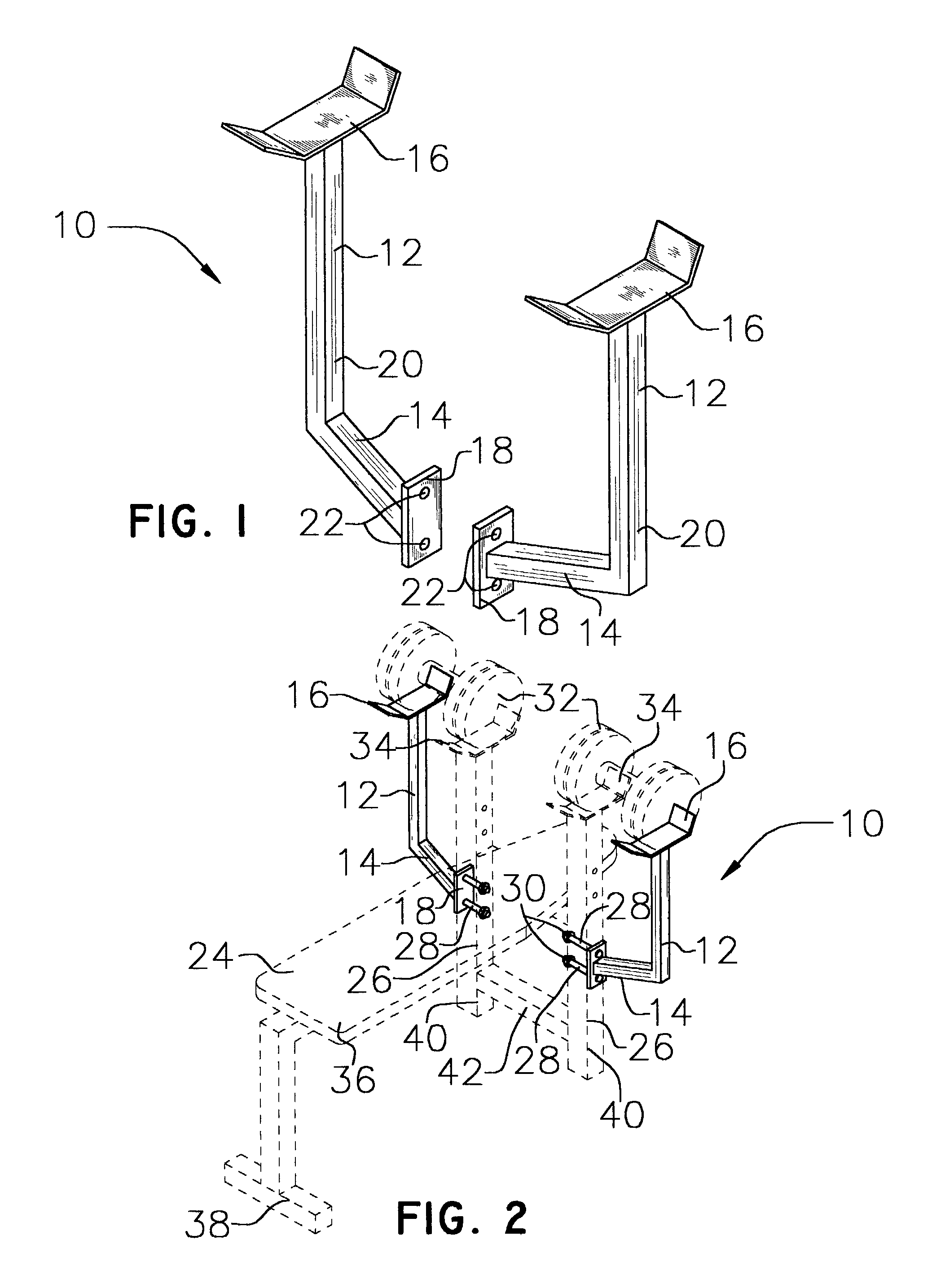When a weightlifter includes dumbbells in his workout
regimen, additional problems come in to play.
If a spotter is not used, the dumbbells are typically lifted from the floor while the weightlifter is
lying on a weight bench, causing undue strain on the shoulders, elbows, and wrists.
However, the majority of health clubs and private owners who currently own weight benches would be unwilling to spend the money to buy a new weight bench solely for the purpose of adding dumbbell supports to the facility.
However, the Schoolfield '898 patent does not provide a sufficient arc in the receiving rests for the weights, and it is conceivable that the user could pull the weight from the receiving rests while attempting to move the weight bar forward, causing
severe injury to the user.
Additionally, the placement of the gas struts on the weight bar precludes the use of the bench for any sitting exercises in which the legs would
straddle the bench.
However, the Reyes '876 patent does not make any provision for the use of dumbbells in association with this structure.
Furthermore, no indication is given in the Reyes '876 patent that additional supports can be added to the existing barbell supports for accomodating dumbbells.
However, the Stevens '543 patent does not include supports for positioning dumbbells for part of the weight training
regimen, neither does it provide an attachment to provide supports for dumbbells.
Furthermore, the Stevens '543 device has the barbell supports positioned behind the portion of the bench on which the user would place his head, which could cause undue stress on the shoulders when initially lifting the barbell from the support and when placing the barbell in the support at the conclusion of the exercise.
Finally, the formation of the Stevens '543 device is such that a spotter can not reach the weight and support bars, rendering him useless to the weightlifter.
However, the Mahnke '865 patent does not provide supports that would be useful for holding dumbbells; thus the user would have to lift dumbbells from the floor, placing his shoulders and arms under an undue amount of stress.
However, the Roethke '934 patent is not freestanding and requires the
fixed position support unit to be secured to a wall or other support member, thus reducing portability of the device.
Additionally, the Roethke '934 patent makes no provision for dumbbell supports built into the
tower, nor does it provide attachments which are able to support dumbbells.
Finally, the Roethke '934 device is inconvenient to use and slows down a workout, requiring time between each exercise set to reconfigure the device.
However, the Roosevelt '260 device is intended strictly for the bench press, and the curved bench precludes doing some exercises that require a flat bench.
Additionally, the Roosevelt '260 device makes no provision for dumbbell supports, either as part of the bench or as attachments to the bench.
Moreover, the bench in the Roosevelt '260 patent does not incline or decline, further limiting the number of exercises that can be performed with this device.
However, the Dawson '921 device is complex, driving up the cost of manufacture and resulting in higher costs to the
consumer.
While the above-described devices fulfill their respective, particular objectives and requirements, the aforementioned patents do not describe a weight bench with dumbbell supports that allows the user to safely execute a workout using both dumbbells and barbells from multiple positions of the bench.
Furthermore, the Schoolfield '898 device could be unsafe to use because it does not provide a sufficient arc in the receiving rests for the weights, and it is conceivable that the user could pull the weight from the receiving rests while attempting to move the weight bar forward, inflicting injury upon himself.
The Stevens '543 device could also
cause injury due to stress placed on the shoulders when the user reaches behind his head to place the barbell on the supports.
The placement of the gas struts on the lower portion of the weight bar in the Schoolfield '898 device precludes the use of the bench for any sitting exercises in which the legs would
straddle the bench, the formation of the Stevens '543 device is such that a spotter can not reach the weight and support bars, rendering him useless to the weightlifter, and the Roosevelt '260 device has a curved bench which precludes doing any exercises requiring a flat bench.
While the Roethke '934 patent allows multiple configurations of the bench, it is inconvenient to use and slows down a workout, requiring time between each exercise set to reconfigure the device.
Moreover, the Roethke '934 device is not freestanding and requires the
fixed position support unit to be secured to a wall or other support member, thus reducing portability of the device.
Finally, the Dawson '921 device is complex, driving up the cost to manufacture and resulting in higher costs to the
consumer.
 Login to View More
Login to View More  Login to View More
Login to View More 

